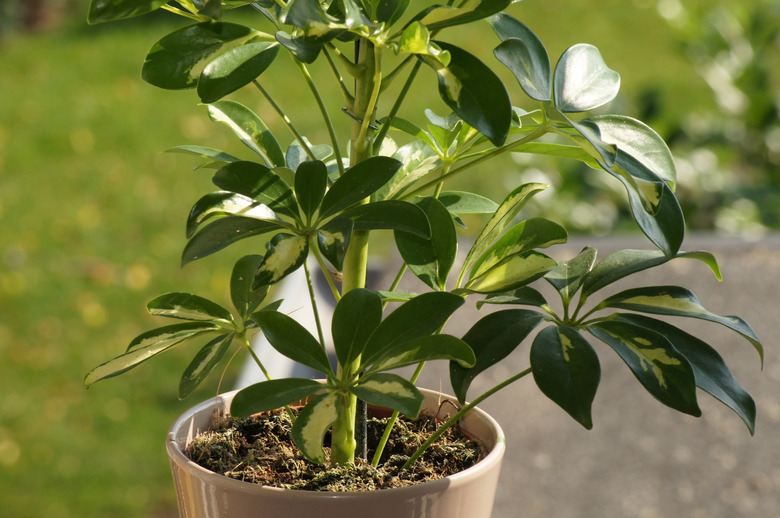Is An Umbrella Tree Poisonous?
We may receive a commission on purchases made from links.
Sometimes, a plant is given a common name that is difficult to understand. With the umbrella tree (Schefflera actinophylla), that is not the case at all. This tropical tree has large, palmlike, shiny leaves positioned atop its thin trunks, looking for all the world like a tall umbrella. Enjoy and appreciate the umbrella tree, but make sure your pets or guests don't nibble on it.
Tip
The umbrella tree is toxic and should not be eaten by humans or pets.
Meet the Umbrella Tree
Meet the Umbrella Tree
The umbrella tree is a desirable houseplant, making any room or patio feel tropical. The trees are fast growers, and when planted outside, they create dense hedges or windbreaks for property lines, but their invasive tendencies outweigh their usefulness. Indoors is a different story.
Grown inside or in a container on the porch, schefflera trees are bold, clean, and imposing houseplants. Given proper sunlight, they grow summer flowers in an unusual arrangement of small blooms on large clusters at the end of the trunks. They are bright red spikes held above the foliage that resemble the ribs of an umbrella. The blossoms develop into small purple fruits.
Understand the Tree's Toxins
Understand the Tree's Toxins
Some trees have toxic fruits, and others have toxic flowers. The toxins of umbrella trees are in the tree sap, which means that every part of the plant is poisonous. The sap contains calcium oxalate crystals that irritate the skin, causing a temporary rash. It's a good idea to wear gloves when pruning the plant and to wash your hands immediately afterward with soap and water. The irritation only lasts a few minutes, but it's better to avoid it if possible.
The calcium oxalate will cause more serious effects if consumed. Anyone who eats the leaves or gets the sap in the mouth may suffer from vomiting. The toxins can also cause a numb sensation in the mouth and difficulty swallowing. This is true for people and pets. The American Society for the Prevention of Cruelty to Animals lists the schefflera among plants toxic to both dogs and cats. The tree is unlikely to cause serious, lasting harm, but it is best to avoid consuming it.
Care of the Umbrella Tree
Care of the Umbrella Tree
Despite the potential risks to people and pets, many people keep umbrella trees as houseplants. Though they only grow in the warmest hardiness zones outdoors, U.S. Department of Agriculture plant hardiness zones 10 through 11, they are fine indoors anywhere. The plants do well in containers, requiring only occasional repotting, and top out at 6 to 8 feet tall, but bonsai plants are available. They propagate easily from cuttings.
Umbrella tree care is easy if you site the plant properly. Place the umbrella tree in bright, indirect light of the kind it would get at an east-, west-, or south-facing window. During the growing season, water it whenever the soil is moderately dry, but cut back on water in winter.
